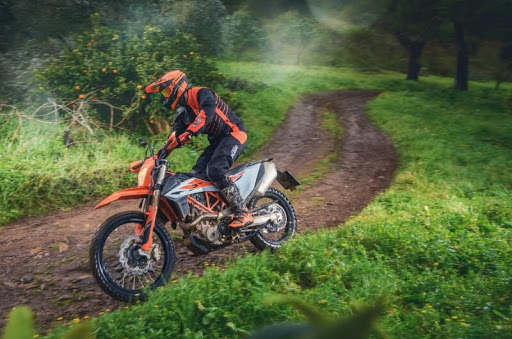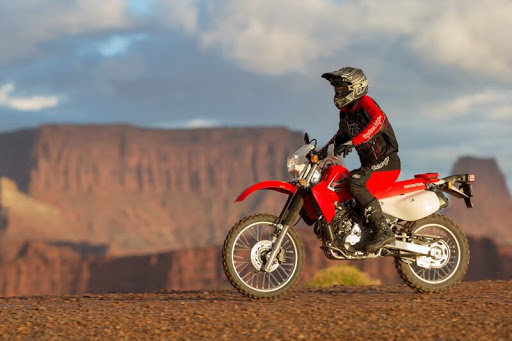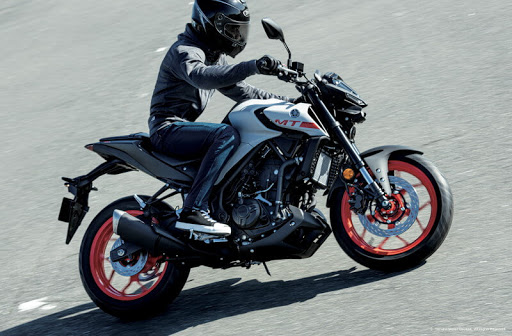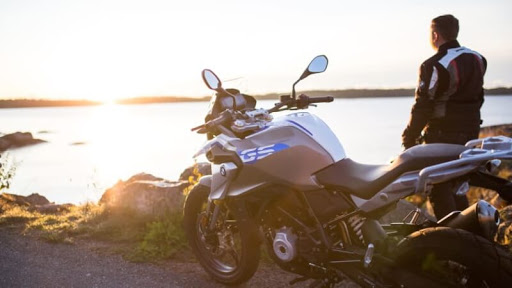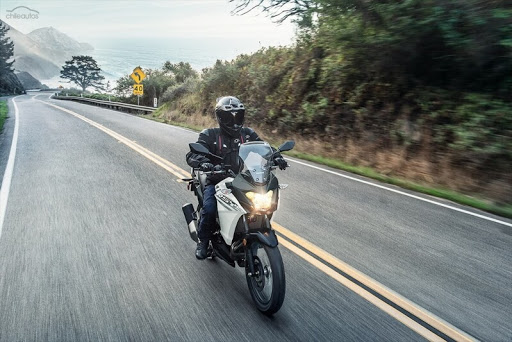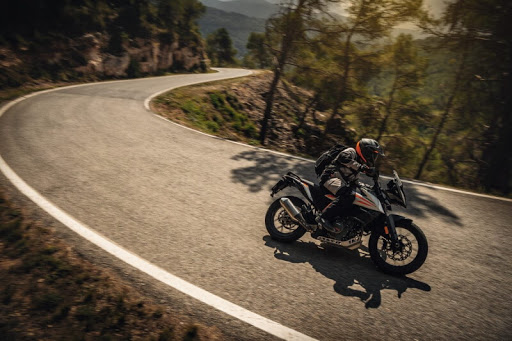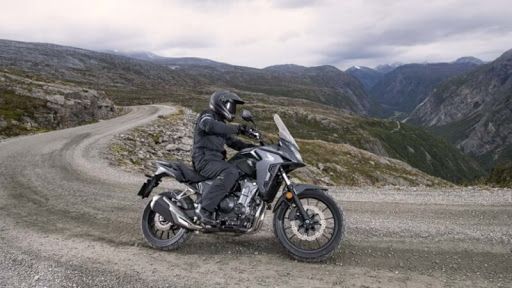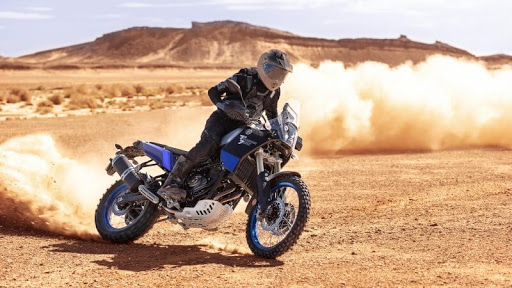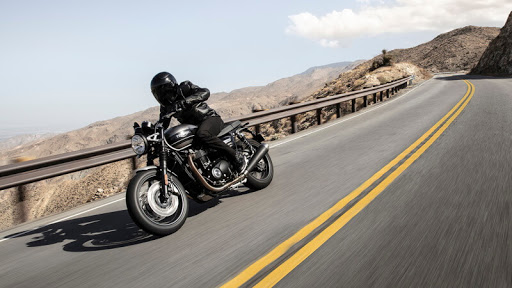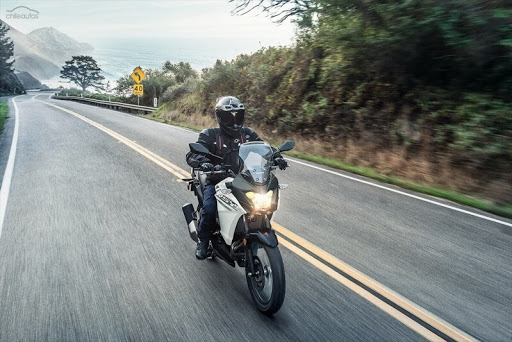
Lightweight Tourers: Top 14 Lightest Motorcycles Compared
Every passing year, motorcycle manufacturers cram more and more features into their touring models. Any day now, we’ll have tourers with built-in dishwashers. Now, I love technology and creature comforts as much as the next guy, but these things add weight. And weight ruins the handling on any bike. This is especially relevant for touring, where negotiating twisties, off-road trails, and (far too much) luggage, are all in a day’s ride. So if you’re looking to find the lightest motorcycle for touring, your quest is indeed a wise one.
At a claimed curb weight of 335 lb (152 kg), the KTM 690 Enduro R is probably the lightest "touring" motorcycle that money can buy today. But it isn’t for everyone; it’s too tall, too pricey, and perhaps too rowdy for many riders’ tastes. Fortunately, there are other options. Before we get into the list, I should probably explain the criteria I’ve used. To keep it as simple as possible, I’ve stuck to just two parameters.
First, the bike needs to be suitable for touring (obviously), even if it isn’t necessarily marketed as a tourer. This means that it should allow a relatively upright riding posture (so you don’t have to end each long ride at a chiropractor’s clinic), offer more than 5 inches of ground clearance (so you don’t have to end an off-road ride because of a cracked crankcase), and enough horsepower to cruise along at freeway speeds, preferably without redlining (so you actually finish your multi-day itinerary, instead of giving up halfway and taking the bus home).
Second, it should have a curb weight under 450 lb (205 kg). This means that machines like BMW’s huge, exalted GS bikes will not make the cut, with their high curb weights. But why 450 lb, you ask? Well, I’ll tell you a secret: 450 is a magic number. Seriously.
Okay, no. The thing is, after analyzing all the touring-suitable motorcycles by popular brands, I’ve discovered that the 440 - 450-lb-mark (200 - 205 kg) seems to be a critical benchmark. For reasons I’m not entirely sure of, there are dozens of touring motorcycle options above this weight, but very few options below it. Also, I’m 5’7” and 125 lb -- not what you’d call a heavyset guy -- but I can manage motorcycles weighing less than 450 lb just fine, so it seems like a good cut-off.
So, with that out of the way, on with the list!
1. KTM 690 Enduro R
Pros: Very light for a tourer
Cons: High seat height, vibrations, expensive
Alright, so it’s an enduro, but KTM themselves market it under the “travel” category. And besides, 74 hp and 54 lb-ft of torque is more than other enduros offer, certainly enough to cover decent distances cruising at high, double-digit miles per hour. Most importantly, the bike has a claimed dry weight of just 321 lb (146 kg). Given its 3.5-gallon gas tank, you can expect a typical curb weight of around 335 lb (152 kg), which, while high for an enduro, is exceptionally light for a touring motorcycle.
Clearly, the 690 Enduro R has a lot going for it, but it’s far from perfect. For a start, the seat height is a ridiculous 35.8 inches high. If you’re anything under 6’2”, you’re going to have a hard time flat-footing the ground while astride this bike. Secondly, “refined” isn’t the word that anybody would use to describe this 700 cc single cylinder engine, or its companion gearbox. The false neutrals and vibration might be bothersome on long rides. Considering all this, the asking price of $11,899 is fairly high.
2. Honda XR650L
Specs: 346 lb (157 kg), 644 cc single cylinder engine, 44 hp, $6,999
Pros: Value for money, legendary reliability
Cons: Low pillion space, not the best for highways
The Honda XR650L is the second lightest bike on this list and at 346 lb (157 kg), just about 10 lb heavier than the 690 Enduro R. What’s more, at $6,999, it’s almost half the price of the expensive KTM, and it’s definitely not half the bike. Thanks to some clever engineering, the bike doesn’t need an oil sump, and so it offers a phenomenal 13 inches of ground clearance. The seat height is 32.7 inches -- still a little challenging for shorter riders, but not as bad as the KTM.
The XR650L is known for legendary Honda reliability, but there are a few flaws. Most riders find that it isn’t as good on the highways as it is off-road. This is partly because of the dirt-biased suspension, but also because some users have occasionally reported issues with high oil temperatures when riding at sustained high RPMs.
3. Kawasaki Z400
Specs: 364 lb (165 kg), 399 cc parallel twin, 44 hp, $4,999
Pros: Super refined motor, loaded with features
Cons: Uncomfortable for pillions on long rides, not user-friendly off-road
Before you dismiss the Z400 as “too small”, “entry-level”, or a “beginner” bike, you should test it out on the open highway. Yes, this bike only makes 44 hp, but it also weighs just 364 lb (165 kg), and that engine loves to be revved. It’ll happily sit near redline RPM all day long, with no drama or vibration to show for it. Combined with its more upright riding position relative to its sister, the Ninja 400, the Z400 is a great highway machine. Add a few simple mods and it can give much bigger tourers a run for their money.
Of course there are other tourers with more than twice the horsepower, but they also come at more than twice the price. With ABS, preload-adjustable rear suspension, and slipper clutch all bundled at $4,999, it’s hard to find fault with this bike. Still, if you plan to do a lot of two-up touring and off-road riding, the Z400 may not be right for you. The ergonomics of the split seat can tire out the pillion on long rides, and most of the torque lies at the higher end of the RPM band, making off-road slopes difficult to deal with.
4. Suzuki DR650S
Specs: 366 lb (166 kg), 644 cc single cylinder engine, 44 hp, $6,699
Pros: Simplicity, ultra rugged construction
Cons: Low on comfort
The DR650S is as simple as a motorcycle can get. This bike has remained more or less unchanged since it was launched 30 years ago -- if it ain’t broke, don’t fix it, right? No ABS, no fuel injection, no electronics. The upside of all this simplicity is that this 366-lb (166-kg), 44 hp motorcycle just works. No matter where in the world you go, the source of your adventure is unlikely to be an issue with this bike.
On the other hand, if you’re used to the comfort and refinement of modern, fuel-injected motorcycles, you may find that you don’t readily take to the DR650S. For one thing, the seat is narrow, hard and uncomfortable. For another, the bike feels a bit noisy and vibey at highway speeds. And, if the carburetor is out of tune (which happened fairly often on my friend’s DR650, for some reason), the bike tends to run rich, guzzle more gas than usual, and bring down the range to around 130 miles (208 km). Nothing that isn’t easily fixed, but still…
5. Yamaha MT-03
Specs: 373 lb (169 kg), 321 cc inline twin, 42 hp, $4,599
Pros: Excellent highway manners
Cons: Limited off-road ability
If you thought the Z400 has a high-revving engine, well, meet the MT-03, with peak power and torque figures at RPMs even higher than the Z400. The MT-03 is about 10 lb (4.5 kg) heavier, and it misses out on several of the fancy features that Z400 offers. This bike also has two fewer horses, but the inline twin is even smoother than Kawasaki’s parallel twin mill. Essentially, what you have is a very good machine for covering distances on tarmac.
Where the tarmac ends, though, the only comfort this bike offers is its good ground clearance of 6.3 inches, and not much else. The ABS isn’t switchable, the suspension is a tad stiff, and there’s very little usable torque at the lower RPMs typical to off-road riding. That said, at $4,599, it is the lowest-priced bike on this list, and for that, it is still a superb machine.
6. BMW G 310 GS
Specs: 374 lb (170 kg), 313 cc single cylinder engine, 34 hp, $5,795
Pros: Great mix of on and off-road capability
Cons: Underpowered, pricey for what it is
When I said earlier that BMW GS bikes aren’t light enough to feature on this list, I was talking about the big GS’s. This “baby” G 310 GS though, fits right in, weighing 374 lb (170 kg), thanks to its single cylinder engine displacing just around 300 cc. The bike is manufactured in India, but when you see it upclose in person, the build quality seems nearly as good as the bigger BMWs.
With 8.6 inches of ground clearance and 7 inches of suspension travel, this bike can do a lot off-road, short of Dakar-rally-style jumps, perhaps. On the road, it cruises adequately, but maxes out at around 90 MPH (145 kmph). ABS comes standard as on all BMW bikes, but still, at $5,795, the price seems a bit on the higher side.
7. Kawasaki Versys-X 300
Specs: 386 lb (175 kg), 296 cc parallel twin, 39 hp, $5,799
Pros: Comfortable, refined
Cons: Torque at high RPMs is difficult to use off-road
The Versys-X 300 is built on the same platform as the Z400 featured earlier, but you wouldn’t know it from riding the two bikes. They feel completely different. Considering that it has four horses less than the Z400, and is 22 lb (10 kg) heavier, it seems strange that Kawasaki expects you to pay $800 more for the Versys X-300. What that money buys you is a more upright riding position, an inch and a half of added ground clearance, a bigger, 19-inch front wheel, about an extra inch of suspension travel, and an added 0.8 gal of fuel capacity.
All this adds up to make a more comfortable tourer than the Z400. The seat design is also more roomy and comfortable for two-up riding. And you can cruise along comfortably all day, courtesy the super-smooth engine. The only gripe I have about the Versys-X 300 is that most of the power and torque is very high on the rev band, which makes it tricky to climb gradients off-road. That, and the ABS doesn’t work very well off-road, sometimes interfering when it really shouldn’t.
8. KTM 390 Adventure
Specs: 392 lb (178 kg), 373 cc single cylinder engine, 43 hp, $6,199
Pros: Big-bike features at small-bike price
Cons: Misses out on plush, big-bike ride quality
The 390 Adventure is based on the platform of KTM’s highly successful Duke 390, so you might call it a supermoto on stilts. Don’t let that label fool you though, because this is no slouch, on or off the road. Users have reported speeds north of 100 MPH, and the bike’s feature list is enough to make a flagship, liter-class bike envious: adjustable suspension, slipper clutch, ride-by-wire, off-road ABS, traction control, cornering ABS, TFT display, smartphone pairing…
But there are a few niggles. For one thing, the engine runs at a high compression ratio, and it’s a single cylinder mill, which means, vibrations. There’s a fair bit of them above 6000 RPM. For another, the suspension is on the firmer side and would be better suited to a supermoto than a touring bike. And lastly, KTM have plonked the same engine from the Duke 390 into the 390 Adventure, with no tweaks to the gearing or tune. So, in what seems to be a recurring theme on this list, the engine needs to be revved high to get the torque needed for off-road inclines, which is difficult for off-road beginners.
9. Yamaha MT-07
Specs: 403 lb (183 kg), 689 cc parallel twin, 74 hp, $7,599
Pros: Point-and-go simplicity
Cons: Suspension is bouncy
Marketing departments work in strange ways. Clearly, somebody at Yamaha’s thought, “Let’s make a 400-lb bike with none of the bells and whistles that middleweight motorcycles have nowadays, it’ll be great!” Funny thing is, they were right. No electronic gadgetry on the MT-07, but it’s still supremely competent at making quick work of long miles.
However, many riders have complained that its suspension isn’t comfortable on bumpy roads, and definitely not great off-road. Strangely, this bike’s ground clearance is less than the MT-03’s -- just 5.5 inches. But, that engine serves up 74 butter-smooth horsepowers, and at $7,599, that’s better value per horsepower than any other bike on this list.
Note: The Yamaha XSR700 is based on the same platform as the MT-07. On paper, the two have nearly identical specifications, but the XSR700 costs almost $1,000 more. If you love retro styling, you might find it worthwhile.
10. Kawasaki Z650
Specs: 412 lb (187 kg), 649 cc parallel twin, 68 hp, $7,349
Pros: Engaging for beginners and advanced riders alike
Cons: Taller riders and pillions may find comfort levels lacking
There are bikes that try to be all things to all people, and the Z650 is one of them. It does a pretty decent job too. With 67 horses rearing to pull this 412-lb machine, and a nearly neutral riding position, most people will find they can ride it all day without too much fatigue. And there isn’t much to distract you either: even ABS is an optional extra (though I highly recommend you opt for it).
The ground clearance is barely over 5 inches, so, off the asphalt, anything but light trails might be challenging. If you’re over 5’11”, or plan to do a lot of riding with a pillion, you might want to try the bike out on a long ride first, since quite a few folks have said that long rides get a bit uncomfortable.
11. Ducati Scrambler Icon
Specs: 427 lb (189 kg), 803 cc L-twin, 73 hp, $9,595
Pros: Great ride quality, comfortable seat
Cons: Tends to run hot, gearbox is a tad clunky
When it was first launched, the Scrambler Icon was positioned as an affordable entry point into the Ducati lineup. But the update in 2019 saw the addition of features like cornering ABS, improved suspension, and hydraulic clutch, meaning it’s no longer an inexpensive motorcycle with its $9,500+ price tag. It’s still probably the most affordable scrambler in this displacement class, and if you like bikes with this classic styling, you’ll be glad to know that this one is a ton of fun to ride.
The pliant suspension soaks up bumps on rough roads, and together with the well-designed seat, the Icon is comfy even for long, two-up rides. But the extent of suspension sag reduces the ground clearance, so you’ll need to be careful when riding off-road. Or, switch to bigger wheels and longer travel suspension. Another drawback is that heat from the engine can get quite uncomfortable, and there are lots of false neutrals between gears. Great to ride on the open road, not so much fun in rush hour traffic.
12. Honda CB500X
Specs: 430 lb (195 kg), 471 cc parallel twin, 49 hp, $6,699
Pros: Highly versatile, comfortable both on and off road
Cons: Slightly heavy for a 470 cc bike
The CB500X is the little brother of Honda’s iconic Africa Twin, and it’s sometimes affectionately called the Halfrica Twin. The price tag may be half that of the Africa Twin’s, but unless you’re some kind of off-road riding god, there's nothing you can do on the Twin that you can't on the CB500X. The ABS variant costs $300 more, and that’s certainly a price worth paying.
49 horsepower doesn’t sound like much, but the bike can comfortably reach speeds of up to 110 mph, and offers good wind protection to reduce fatigue. There's 32 ft-lb of torque spread evenly across the RPM band, so overtaking and off-road riding is easy. If I had to nitpick, I’d say that although light for an adventure bike, it’s still a tad heavy for a 470 cc twin. The Z650 and MT-07 for instance, are both twin-cylinder machines with bigger engines, and they’re about 15 - 20 lbs lighter.
13. KTM 790 Adventure
Specs: 448 lb (203 kg), 799 cc parallel twin, 95 hp, $12,699
Pros: Go-anywhere capability, electronic rider aids
Cons: High seat height
I haven’t ridden the 790 Adventure, but based on what others are saying about it, I can't wait to get my hands on it. It’s the lightest adventure bike in its displacement class, and has everything from adjustable suspension, to rider modes, traction control, and off-road as well as cornering ABS.
Despite boasting 10 inches of ground clearance, the bike reportedly has a very low centre of gravity thanks to the fuel tank being relocated low down, around the engine. This makes it easy to handle and maneuver, especially off-road and at low speeds. The only real negative I’ve heard about the 790 Adventure is that the seat is rather high at 34.6 inches, making it somewhat challenging for uh… vertically-challenged riders (like me).
14. Ducati Hypermotard 950
Pros: Possibly the ultimate do-anything bike
Cons: Expensive, high seat height
If you want just one motorcycle that you can enjoy at the race track, and on mountain twisties, and on off-road trails, well, the Hypermotard 950 is probably the bike for you. Some make that claim about its bigger cousin, the Multistrada, but don’t believe them -- nobody really wants to throw a 530-lb beast around on rutted, off-road terrain. At 450 lb (204 kg) though, the Hypermotard just might be manageable, even if it isn’t what you’d call a featherweight.
Somehow, even with 8.3 inches of ground clearance, the Hyper still corners and handles in a way that rivals many sport bikes. Its riotous L-twin pumps out 114 horses, so it also walks the talk. And despite its 17-inch wheels, it still has off-road abilities that any “soft roader” would envy. I know many motorcyclists, but I don’t know anyone who has ridden this bike and come away saying they didn’t like it -- a very rare thing with motorcycles. At $13,395, it is expensive, but if it can simplify a three-bike garage into a one-bike garage, that’s still great value.
Bonus
Yes, this list was supposed to have only the top 14 touring-friendly motorcycles, but because you’re so good, here are four more bikes that almost made the 450-lb cut-off, but not quite.
Specs: 452 lb, 689 cc parallel twin, 72 hp, $9,999
Specs: 463 lb, 1200 cc parallel twin, 96 hp, $12,200
Specs: 464 lb, 900 cc parallel twin, 65 hp, $9,300
Specs: 467 lb, 896 cc V-twin, 93 hp, $10,999

